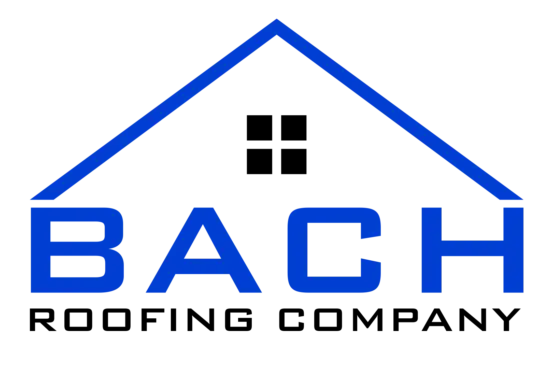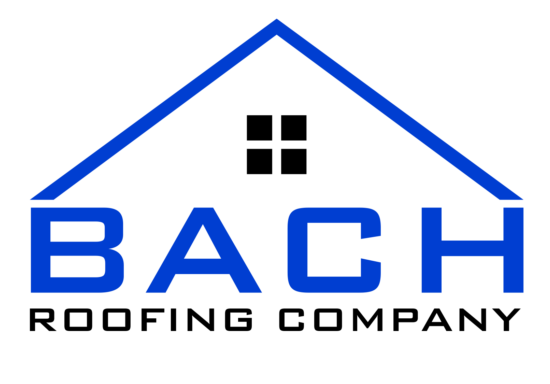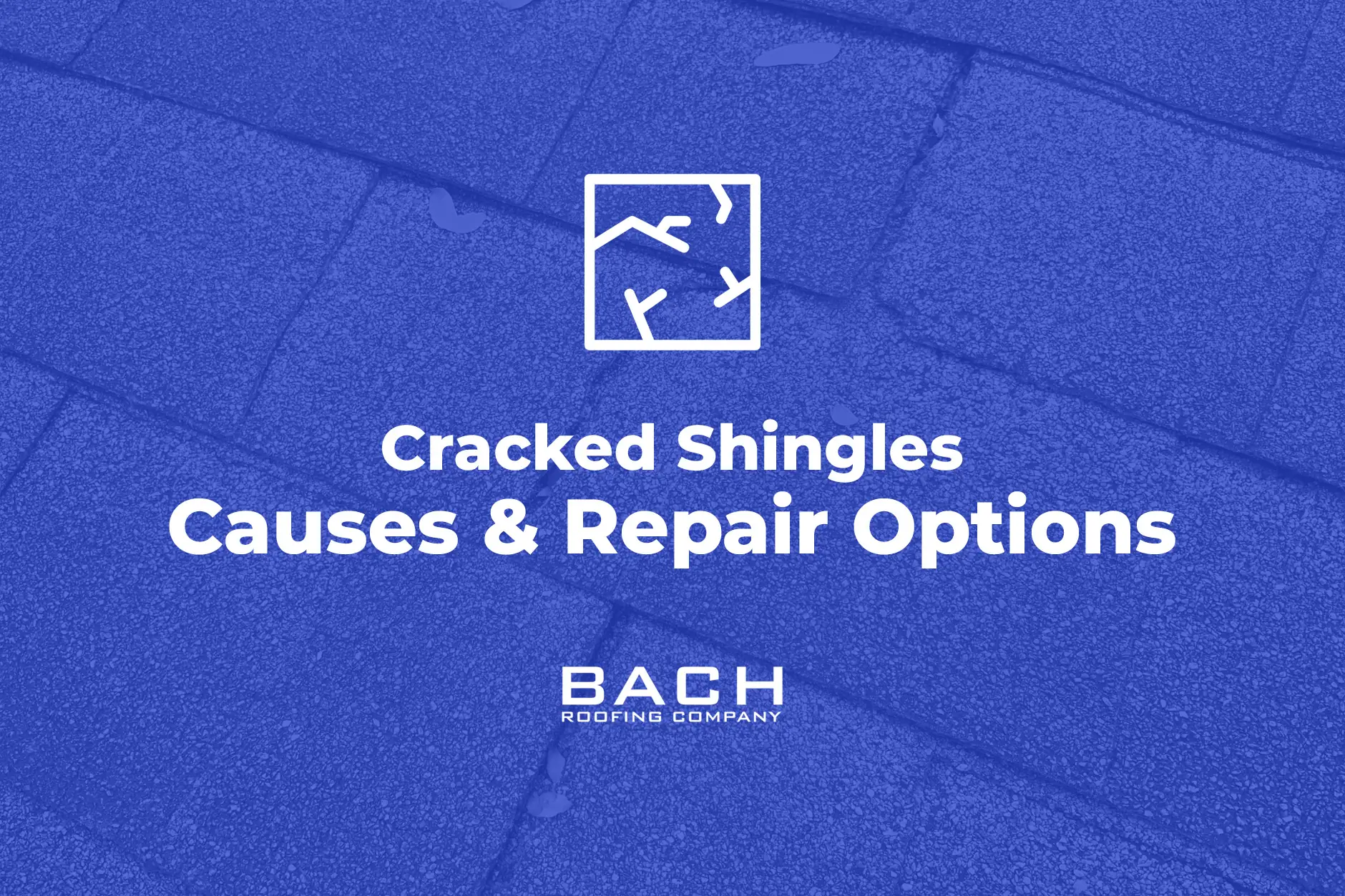Table of Contents
Spring has arrived in Michigan, so many homeowners are doing outside work like gutter cleaning and roof inspection. If you notice cracked shingles while working on your roof, it’s important to act immediately, as they can lead to bigger problems if ignored. Depending on the extent of the cracking, your home could be one rainstorm away from a major crisis. Rainwater can sneak underneath, and once moisture finds its way in, it can do serious damage.
In this article, we’ll go over why shingles crack in the first place, what to look out for, and the recommended repair options. We’ll also highlight how, if you’re in the tri-county area, Bach Roofing can help you correct the damage and fortify your home.
What Causes Shingles to Crack?
Cracked shingles rarely result from sudden damage. Between rainstorms, winter blizzards, and even seasonal hail, your roof takes a beating all year long, and that wear adds up. Installation technique and even roof age can also play a role, as we’ll explain below.
Temperature Swings
Michigan weather isn’t kind to shingles, especially those made from asphalt. When temperatures rise, shingles expand, and when it gets cold again, they contract. When this movement happens day after day, season after season, the materials weaken over time. The result is small cracks that grow larger if left unaddressed. Older shingles are especially prone to this because they’ve been through more freeze-thaw cycles and have less flexibility left in them.
Sun Exposure
Shingles soak up a lot of sun, and that heat takes a toll. Constant UV exposure dries out the asphalt and breaks down the protective layers. Once the surface becomes brittle, it can’t bend or shift as easily, and a small impact or temperature drop might be enough to cause a split. South-facing roofs and spots without tree cover usually wear out faster than shaded areas.
Wind and Impact Damage
Strong wind gusts can lift shingles or break the seal that holds them in place. Once that happens, the shingles flap or shift around, and cracks can follow. Flying debris, like branches or even blown leaves over time, can scrape across the surface and cause microscopic tears that gradually widen. Hail can also do damage, especially if the shingles are already worn down. Even if you don’t actually see pieces missing, small cracks can still be present and eventually let water in.
Poor Installation
Unfortunately, not all roofing work is done to the same standard. If the shingles were nailed incorrectly or placed too tightly against each other, they can’t flex as they should. That puts extra stress on the material during temperature changes. Shingles that weren’t properly sealed during installation may also be more vulnerable to wind and moisture. These issues can take years to show up, so even if your roof seems to be in good condition on the surface, problems may be developing.
Problem Areas on the Roof
Some parts of a roof naturally wear out faster than others. Shingles near chimneys, skylights, dormers, and roof vents are under more pressure because of how water flows around them: these areas can collect moisture, and if flashing isn’t done well, the shingles there are more likely to crack. Heat from vents or chimneys can also speed up the aging process for nearby materials.
Age
Most asphalt shingles last 15 to 30 years, depending on the quality and weather exposure. As they get older, the oils in the shingles dry out, and the material becomes stiff. As we explained earlier, once shingles lose flexibility, they can’t handle pressure or movement well. Cracks show up more easily, especially after storms or extreme temperature swings.
How to Inspect Your Roof for Cracked Shingles
If your asphalt shingles are cracking, you’ll want to spot the issue sooner rather than later. Below is an overview of the various ways that you can check for damage.
Start From the Ground
Begin by walking around your home and looking up at the roof from different angles. Use a pair of binoculars if you have them. You’re looking for anything that stands out, such as shingles that appear curled, lifted, discolored, or broken. Cracks may show as fine lines across the surface or look like missing pieces along the edges. If you see a section that doesn’t match the rest, take a closer look.
You should also check the ground for pieces of shingles. If you see granules or broken fragments near your foundation or in your gutters, that’s a warning sign, as cracked shingles often shed these bits before they fall apart completely.
Check the Attic
If you have an attic, wait until the next sunny day. Then turn off the lights and look for beams of light coming through the roof boards. If light can get in, water can too. Also, check for any signs of staining or damp spots on the wood: both conditions often show up before an actual leak appears inside your living space.
Use a Ladder for Closer Inspection (If Safe)
If you’re comfortable using a ladder and have someone nearby to spot you, you can get a better view of roof areas that seem worn. Look at valleys, roof edges, and the shingles near vents, chimneys, and skylights. Scan each row for splits, especially ones running in straight lines. Use your hand to gently press on any questionable shingles; if they feel dry, cracked, or crumble under pressure, they need attention.
If you’re unsure about what you’re seeing or don’t feel comfortable inspecting the roof yourself, it’s a good time to bring in a trusted Michigan roofing contractor. At Bach Roofing, we can carry out a detailed inspection and help you deal with any cracked shingles before they compromise the integrity of your home.
Repair Options for Cracked Shingles
Once you’ve confirmed that your shingles are cracked, it’s time to review repair options. The right approach depends on how many shingles are affected, the age of your roof, and how long the damage has been there. Some fixes are quick and easy, while others may call for a more thorough repair.
Spot Repairs
If only a few shingles are cracked and the rest of your roof is still in good shape, spot repairs are usually the best option. This involves lifting the surrounding shingles, removing the damaged one, and sliding in a new shingle in its place. A roofing professional will make sure the seal and nails are secure so the repair holds up.
Sometimes the cracks are small enough that a roofing sealant can do the job. A high-quality roofing adhesive is applied to the cracked area to seal it and stop water from getting in. This works best on newer shingles that haven’t lost their strength or flexibility. It’s a good short-term fix, but it may not last as long as a full replacement.
Partial Replacement
If the cracks are showing up in more than one area but the roof is still in reasonably secure condition, you may want to replace just one section. This option is common for areas near chimneys, roof edges, or spots that get more sun or wind. A partial replacement saves money and gives you more time before you need a full roof replacement.
It’s important to remember that the new shingles may not match the color of the older ones. Over time, the sun and weather can fade the original roof, so the patch might stand out. That’s not always a problem, especially if the area isn’t visible from the ground, but it’s something to consider.
Full Roof Replacement
If cracks are showing up all over and the roof is past its expected lifespan, a full replacement may be your best bet. At that point, repairs would only buy you a little time before more damage appears. A new roof gives you peace of mind and protects your home for years to come. It also gives you the chance to upgrade materials or improve ventilation if needed.
It’s not always easy to tell when a full replacement is the better option. That’s where a roofing inspection can help. An experienced roofing contractor will assess the condition of your shingles, check for signs of water damage, and let you know whether repairs or replacement is more appropriate. At Bach Roofing, we’ll walk you through the options and help you make a decision that fits your situation and your budget.
How Long Does It Take to Replace Cracked Shingles?
In most cases, replacing a small number of cracked shingles is a quick task. If the damage is limited to one or two areas and the weather cooperates, the work can often be completed in a few hours. A roofer will remove the damaged shingles, inspect the underlayment for moisture or wear, and install new ones that blend as closely as possible with the rest of the roof.
If the cracks are widespread or tied to issues like curling, broken seals, or damaged flashing, the repair may take longer. Additional time may also be needed if the shingles are difficult to access or if structural repairs are required underneath. The roofer will let you know how much time to expect once the inspection is complete and the full scope of the work is clear.
Can Cracked Shingles Affect Your Home’s Energy Efficiency?
Yes. Cracked shingles break the seal that helps keep outdoor air and moisture out of your home. Even a small break in the roofing surface can let air escape or enter, which disrupts the insulation layer beneath. When this happens, your heating and cooling systems have to work harder to maintain a stable indoor temperature.
Over time, that added strain can lead to higher energy bills and reduce the comfort level inside your home. In colder months, heat may escape through the roof more quickly. In the summer, hot air can seep in and force your air conditioner to run more often. Addressing cracked shingles early helps preserve energy efficiency and protect your home’s overall performance.
Are Your Shingles Cracking? Call a Michigan Roofing Contractor
A cracked shingle might seem minor, but it creates an entry point for water and exposes your roof to further deterioration. Once moisture reaches the layers beneath, it can weaken the structure, lead to interior damage, and create problems that extend well beyond the roof itself. What could have been resolved with a simple repair may turn into a larger project if left unattended.
At Bach Roofing, we take a straightforward approach to roof care. If we inspect your shingles and find that repair is the right move, we’ll handle it for you. If replacement is a better long-term solution, we’ll explain why and help you plan accordingly. Whatever the next step may be, you can count on workmanship that meets high standards and a team that respects your time and property. To schedule a free roof inspection, call us at (586) 244-2086 or submit a quote request online. We proudly serve Harrison Township and nearby areas, so contact us today.


